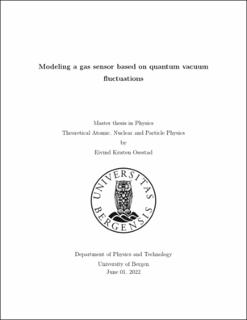| dc.description.abstract | This thesis presents a model of a gas sensor that uses quantum vacuum fluctuations to find the concentration of CO2 in a mixture of other gases, to demonstrate that such a sensor might be possible to make. Our model is a hollow-core fiber of silicon dioxide with spheres of different dielectric materials suspended in an optical trapping potential generated by a standing laser field. We show that there are dispersion forces between the fiber and the spheres due to virtual photons propagating from the sphere through the gas, scattering off the wall, and propagating back to the spheres. We show how this leads to the gas mixture screening the dispersion force by a different amount for the different spheres, leading to different changes in trapping frequency. Finally, an artificial neural network is trained to find the relationship between the trapping frequencies and the partial pressure of CO2 in the mixture. Thus, we show that the gas concentration can be measured using quantum vacuum fluctuation, and achieve a mean square error of 4.27 times 10 to the negative 9th atmospheres squared. | |
